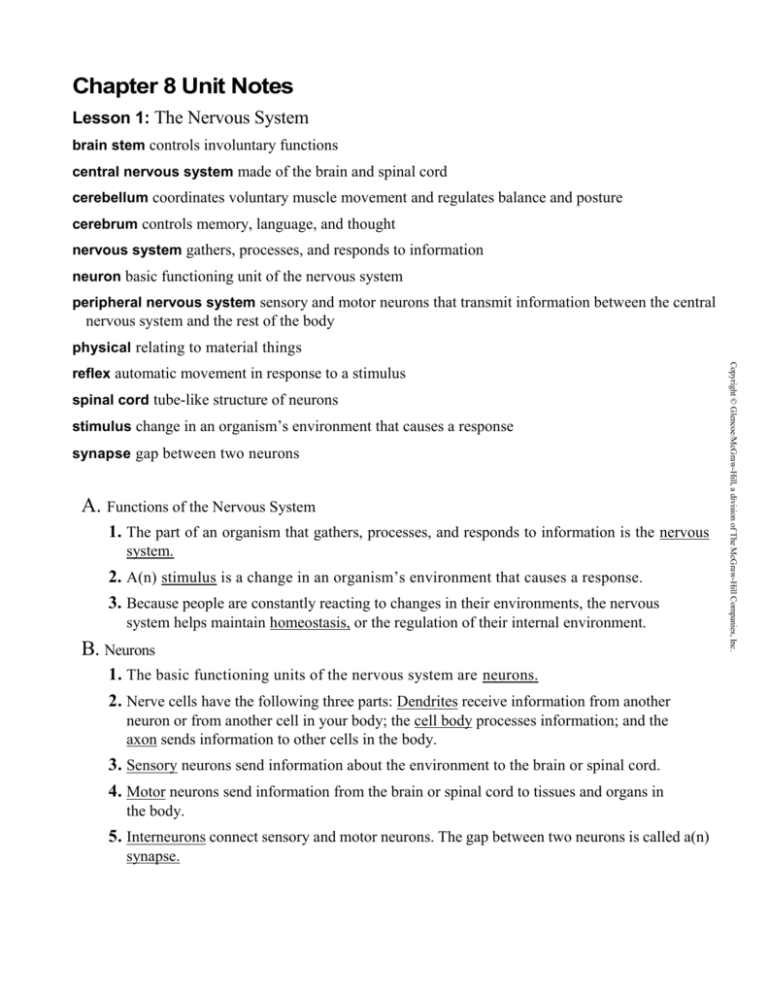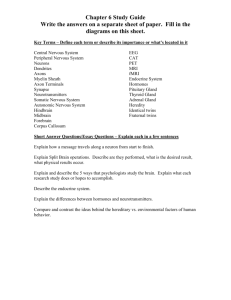Control and Coordination
advertisement

Chapter 8 Unit Notes Lesson 1: The Nervous System brain stem controls involuntary functions central nervous system made of the brain and spinal cord cerebellum coordinates voluntary muscle movement and regulates balance and posture cerebrum controls memory, language, and thought nervous system gathers, processes, and responds to information neuron basic functioning unit of the nervous system peripheral nervous system sensory and motor neurons that transmit information between the central nervous system and the rest of the body physical relating to material things spinal cord tube-like structure of neurons stimulus change in an organism’s environment that causes a response synapse gap between two neurons A. Functions of the Nervous System 1. The part of an organism that gathers, processes, and responds to information is the nervous system. 2. A(n) stimulus is a change in an organism’s environment that causes a response. 3. Because people are constantly reacting to changes in their environments, the nervous system helps maintain homeostasis, or the regulation of their internal environment. B. Neurons 1. The basic functioning units of the nervous system are neurons. 2. Nerve cells have the following three parts: Dendrites receive information from another neuron or from another cell in your body; the cell body processes information; and the axon sends information to other cells in the body. 3. Sensory neurons send information about the environment to the brain or spinal cord. 4. Motor neurons send information from the brain or spinal cord to tissues and organs in the body. 5. Interneurons connect sensory and motor neurons. The gap between two neurons is called a(n) synapse. Copyright © Glencoe/McGraw-Hill, a division of The McGraw-Hill Companies, Inc. reflex automatic movement in response to a stimulus C. The Central Nervous System 1. The central nervous system has two parts: the brain and the spinal cord. 2. The CNS (central nervous system) receives, processes, stores, and transfers information. 3. The part of the brain that controls memory, language, and thought is the cerebrum. 4. The part of the brain that coordinates voluntary muscle movement and regulates balance and posture is the cerebellum. 5. The area of the brain that controls involuntary functions is the brain stem. 6. The spinal cord is a tube-like structure of neurons. It sends information back and forth between the brain and the rest of the body. D. The Peripheral Nervous System 1. The peripheral nervous system has sensory neurons and motor neurons that transmit information between the CNS and the rest of the body. 2. The somatic system of the PNS (peripheral nervous system) controls skeletal muscles. blood vessels and the beating of the heart. It also controls cardiac muscles and smooth muscles. E. Nervous System Health 1. Physical injuries are the most common way the nervous system can be damaged. 2. Paralysis is loss of muscle function and sometimes loss of feeling. The injured nerves can no longer send and receive signals. 3. An automatic movement in response to a stimulus is a(n) reflex. 4. Many drugs affect the nervous system by speeding up or slowing down the communication between neurons. F. The Nervous System and Homeostasis 1. The body maintains homeostasis by receiving information from the environment and responding to it. 2. The nervous system senses changes in the environment and signals other systems to make adjustments. Copyright © Glencoe/McGraw-Hill, a division of The McGraw-Hill Companies, Inc. 3. The autonomic system of the PNS regulates involuntary actions such as dilating Lesson 2: The Senses eardrum thin membrane between the outer ear and the inner ear receptor special structure within the sensory system that detects stimuli retina area at the back of the eye that contains photoreceptors rod photoreceptor in the eye that distinguishes shapes of objects sensory system part of the nervous system that detects or senses the environment wave disturbance that transfers energy without transferring matter A. You and Your Environment 1. The sensory system is the part of the nervous system that detects the environment. 2. A human uses five senses—vision, hearing, smell, taste, and touch—and detects his or her environment. 3. All parts of the sensory system have special structures called receptors that detect stimuli. B. Vision 1. The lens and cornea of the eye work together to focus light onto the retina. 2. The retina is an area at the back of the eye that has two types of cells with photoreceptors—rod cells and cone cells. a. Rod cells detect shapes and low levels of light. b. Cone cells detect color and bright light. 3. The retina takes information about objects the eye sees and sends it as electrical signals through the optic nerve to the brain. 4. The brain uses information from the eye and creates a picture of what the person is seeing. 5. Glasses or contacts can be used to correct vision problems by correctly focusing light on the retina. C. Hearing 1. The vibration of matter creates sound waves, which can travel through air and other substances. 2. The outer ear collects sound waves that make the eardrum vibrate. 3. The eardrum is a thin membrane between the outer ear and the middle ear. 4. The inner ear converts sound waves into messages that are sent to the brain. 5. Fluid-containing parts of the inner ear, the semicircular canals, help maintain balance. D. Smell 1. Humans have hundreds of receptors for detecting smell. 2. Odors are molecules that can be detected by chemoreceptors in the nose. E. Taste 1. Chemoreceptors on the tongue are called taste buds. 2. Chemoreceptors in the nose and mouth work together to produce the sense of taste. F. Touch 1. Touch receptors in the skin can detect temperature, pain, and pressure. 2. Touch receptors send messages to the brain for processing. G. Senses and Homeostasis 1. The five senses collect information about the environment. The brain responds to this information and activates the body to maintain homeostasis. 2. Responding to the information received from the nervous system, the brain activates the body to maintain homeostasis. Lesson 3: The Endocrine System endocrine system consists of organs and tissues that release chemical messages into the bloodstream hormone chemical produced by an endocrine gland in one part of an organism and carried in the bloodstream to another part negative feedback control system where the effect of a hormone inhibits further release of the hormone positive feedback control system in which the effect of a hormone causes more of the hormone to be released A. Functions of the Endocrine System 1. The endocrine system consists of groups of organs and tissues that release chemical messages into the bloodstream. 2. Endocrine tissues that secrete chemical messages are glands. 3. A(n) hormone is a chemical message produced by an endocrine gland. The bloodstream carries these messages to other parts of the organism. 4. The messages sent by the endocrine system are transmitted less rapidly than messages sent by the nervous system. B. Endocrine Glands and Their Hormones 1. Hormones affect the functions of organs and tissues. A hormone message is produced for a specific target cell. 2. After a hormone finds the target cell, it binds to a receptor protein in the cell and delivers its chemical message. The target cell responds with the appropriate action. 3. Hormones secreted by the pituitary gland regulate body functions, control other endocrine glands, and cause growth. 4. The thyroid gland controls how the body uses energy. 5. The two adrenal glands release hormones that enable the body to respond to stress and react quickly. 6. The hypothalamus receives information from the nervous system and controls the activity of the pituitary gland. 7. The four parathyroid glands regulate the release of calcium into the blood. 10.The two testes in males are responsible for releasing testosterone and producing sperm cells for reproduction. 11.The two ovaries in females are responsible for releasing estrogen and producing egg cells for reproduction. C. The Endocrine System and Homeostasis 1. Glands help maintain homeostasis by releasing hormones, which change the function of tissues and organs. 2. Negative feedback is a control system where the effect of a hormone inhibits further release of the hormone. The endocrine system uses negative feedback and controls the amount of hormone that a(n) gland releases. 3. Positive feedback is a control system in which the effect of a hormone causes more of the hormone to be released. 4.Whereas negative feedback helps maintain homeostasis, positive feedback does not. Copyright © Glencoe/McGraw-Hill, a division of The McGraw-Hill Companies, Inc. 8. The thymus gland signals the immune system to produce cells to fight infections. 9. The pancreas secretes insulin and glucagon, which regulate the level of sugars in the blood.









